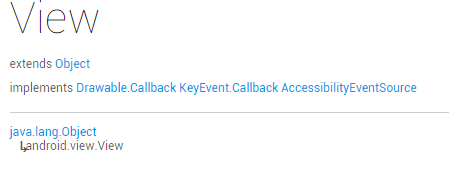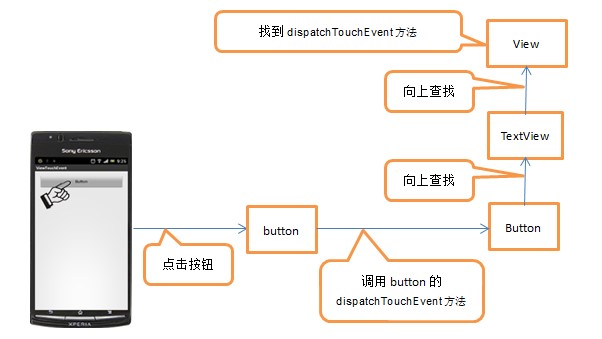参考资料:http://blog.csdn.net/guolin_blog/article/details/9097463
官方View的树状图:

View的子类:ImageView、TextView、Button …… 很多
解析View的onClick和OnTouch的处理机制
以一个可点击的控件为例:button
在Activity中给button注册一个点击事件:
button.setOnClickListener(new View.OnClickListener() {
@Override
public void onClick(View v) {
Log.e("button:", "onClick");
}
});再给button注册一个触摸的事件,即touch事件
button.setOnTouchListener(new View.OnTouchListener() {
@Override
public boolean onTouch(View v, MotionEvent event) {
Log.e("button:", "onTouch" + event.getAction());
return false;
}
});onTouch事件会执行手指按下、手指移动、手指抬起这三个事件。
如果onClick和onTouch事件都注册了,那先执行那个呢?我们编个demo,运行一下就知道了,运行结果如下:

onTouch后面的数字含义:0–ACTION_DOWN;1–ACTION_UP;2–ACTION_MOVE。
由此可见,先执行onTouch,然后传递给onClick。(onTouch执行了多次是因为手指可能抖动了)
我们可以看到在onTouch方法里有返回值,且为false,那如果设置为true,会是什么样的结果呢,测试结果如下:

没有执行onClick方法。
总结:onTouch返回false,事件可以传递给onClick方法;onTouch返回true,事件不会传递给onClick方法。
那这是为什么呢?接下来,我们就用源码说话。
首先,我们触摸到任何一个控件,都会调用该控件的dispatchTouchEvent()方法,我们找到这个方法看一下 :

如图所示,我们在View中找到了这个方法(button继承TextView,TextView继承View),dispatchTouchEvent()方法的源码如下:
/**
* Pass the touch screen motion event down to the target view, or this
* view if it is the target.
*
* @param event The motion event to be dispatched.
* @return True if the event was handled by the view, false otherwise.
*/
public boolean dispatchTouchEvent(MotionEvent event) {
// If the event should be handled by accessibility focus first.
if (event.isTargetAccessibilityFocus()) {
// We don't have focus or no virtual descendant has it, do not handle the event.
if (!isAccessibilityFocusedViewOrHost()) {
return false;
}
// We have focus and got the event, then use normal event dispatch.
event.setTargetAccessibilityFocus(false);
}
boolean result = false;
if (mInputEventConsistencyVerifier != null) {
mInputEventConsistencyVerifier.onTouchEvent(event, 0);
}
final int actionMasked = event.getActionMasked();
if (actionMasked == MotionEvent.ACTION_DOWN) {
// Defensive cleanup for new gesture
stopNestedScroll();
}
if (onFilterTouchEventForSecurity(event)) {
//noinspection SimplifiableIfStatement
ListenerInfo li = mListenerInfo;
if (li != null && li.mOnTouchListener != null
&& (mViewFlags & ENABLED_MASK) == ENABLED
&& li.mOnTouchListener.onTouch(this, event)) {
result = true;
}
if (!result && onTouchEvent(event)) {
result = true;
}
}
if (!result && mInputEventConsistencyVerifier != null) {
mInputEventConsistencyVerifier.onUnhandledEvent(event, 0);
}
// Clean up after nested scrolls if this is the end of a gesture;
// also cancel it if we tried an ACTION_DOWN but we didn't want the rest
// of the gesture.
if (actionMasked == MotionEvent.ACTION_UP ||
actionMasked == MotionEvent.ACTION_CANCEL ||
(actionMasked == MotionEvent.ACTION_DOWN && !result)) {
stopNestedScroll();
}
return result;
}我们主要看31–43行这段代码。我们看下这句:
if (li != null && li.mOnTouchListener != null && (mViewFlags & ENABLED_MASK) == ENABLED&& li.mOnTouchListener.onTouch(this, event))
这里面总共有四个条件,我们看后面三个:
①、li.mOnTouchListener!=null,这个只要们给控件设置了触摸监听器,即button.setOnTouchListener(new OnTouchListener()…),这就不可能是null;
②、(mViewFlags&ENABLED_MASK)==ENABLED,这个意思应该就是控件是enabled的,即可点击的,如:button是可点击的,TextView就是不可点击的(不过可以在布局里面设置 android:clickable=”true”就成可点击的了)
③li.mOnTouchListener.onTouch(this,event),这个方法就是我们自己实现的onTouch()方法,我们知道先执行onTouch,然后传递给onClick。所以这个条件的真假我们是可以控制的,我们先看源码中的19行:boolean result = false,即result的初始值为false;onTouch的返回值分析如下:
若是false,则result = true,不会执行,这时result的值还是false,则第40行 if (!result && onTouchEvent(event))中的!result就是true,然后onTouchEvent(event)就可以执行了,然后事件就传递给onClick了,即onClick方法在onTouchEvent()方法中。
若是true,则三个条件成立,result = true就会执行,这时result的值为ture,则第40行if (!result && onTouchEvent(event))中的!result就是false,那onTouchEvent(event)就不会执行了,所以onClick方法没有执行。
由上述可知,onClick方法在onTouchEvent方法中,接下来我们就看下onTouchEvent()方法的源码:
/**
* Implement this method to handle touch screen motion events.
* <p>
* If this method is used to detect click actions, it is recommended that
* the actions be performed by implementing and calling
* {@link #performClick()}. This will ensure consistent system behavior,
* including:
* <ul>
* <li>obeying click sound preferences
* <li>dispatching OnClickListener calls
* <li>handling {@link AccessibilityNodeInfo#ACTION_CLICK ACTION_CLICK} when
* accessibility features are enabled
* </ul>
*
* @param event The motion event.
* @return True if the event was handled, false otherwise.
*/
public boolean onTouchEvent(MotionEvent event) {
final float x = event.getX();
final float y = event.getY();
final int viewFlags = mViewFlags;
final int action = event.getAction();
if ((viewFlags & ENABLED_MASK) == DISABLED) {
if (action == MotionEvent.ACTION_UP && (mPrivateFlags & PFLAG_PRESSED) != 0) {
setPressed(false);
}
// A disabled view that is clickable still consumes the touch
// events, it just doesn't respond to them.
return (((viewFlags & CLICKABLE) == CLICKABLE
|| (viewFlags & LONG_CLICKABLE) == LONG_CLICKABLE)
|| (viewFlags & CONTEXT_CLICKABLE) == CONTEXT_CLICKABLE);
}
if (mTouchDelegate != null) {
if (mTouchDelegate.onTouchEvent(event)) {
return true;
}
}
if (((viewFlags & CLICKABLE) == CLICKABLE ||
(viewFlags & LONG_CLICKABLE) == LONG_CLICKABLE) ||
(viewFlags & CONTEXT_CLICKABLE) == CONTEXT_CLICKABLE) {
switch (action) {
case MotionEvent.ACTION_UP:
boolean prepressed = (mPrivateFlags & PFLAG_PREPRESSED) != 0;
if ((mPrivateFlags & PFLAG_PRESSED) != 0 || prepressed) {
// take focus if we don't have it already and we should in
// touch mode.
boolean focusTaken = false;
if (isFocusable() && isFocusableInTouchMode() && !isFocused()) {
focusTaken = requestFocus();
}
if (prepressed) {
// The button is being released before we actually
// showed it as pressed. Make it show the pressed
// state now (before scheduling the click) to ensure
// the user sees it.
setPressed(true, x, y);
}
if (!mHasPerformedLongPress && !mIgnoreNextUpEvent) {
// This is a tap, so remove the longpress check
removeLongPressCallback();
// Only perform take click actions if we were in the pressed state
if (!focusTaken) {
// Use a Runnable and post this rather than calling
// performClick directly. This lets other visual state
// of the view update before click actions start.
if (mPerformClick == null) {
mPerformClick = new PerformClick();
}
if (!post(mPerformClick)) {
performClick();
}
}
}
if (mUnsetPressedState == null) {
mUnsetPressedState = new UnsetPressedState();
}
if (prepressed) {
postDelayed(mUnsetPressedState,
ViewConfiguration.getPressedStateDuration());
} else if (!post(mUnsetPressedState)) {
// If the post failed, unpress right now
mUnsetPressedState.run();
}
removeTapCallback();
}
mIgnoreNextUpEvent = false;
break;
case MotionEvent.ACTION_DOWN:
mHasPerformedLongPress = false;
if (performButtonActionOnTouchDown(event)) {
break;
}
// Walk up the hierarchy to determine if we're inside a scrolling container.
boolean isInScrollingContainer = isInScrollingContainer();
// For views inside a scrolling container, delay the pressed feedback for
// a short period in case this is a scroll.
if (isInScrollingContainer) {
mPrivateFlags |= PFLAG_PREPRESSED;
if (mPendingCheckForTap == null) {
mPendingCheckForTap = new CheckForTap();
}
mPendingCheckForTap.x = event.getX();
mPendingCheckForTap.y = event.getY();
postDelayed(mPendingCheckForTap, ViewConfiguration.getTapTimeout());
} else {
// Not inside a scrolling container, so show the feedback right away
setPressed(true, x, y);
checkForLongClick(0);
}
break;
case MotionEvent.ACTION_CANCEL:
setPressed(false);
removeTapCallback();
removeLongPressCallback();
mInContextButtonPress = false;
mHasPerformedLongPress = false;
mIgnoreNextUpEvent = false;
break;
case MotionEvent.ACTION_MOVE:
drawableHotspotChanged(x, y);
// Be lenient about moving outside of buttons
if (!pointInView(x, y, mTouchSlop)) {
// Outside button
removeTapCallback();
if ((mPrivateFlags & PFLAG_PRESSED) != 0) {
// Remove any future long press/tap checks
removeLongPressCallback();
setPressed(false);
}
}
break;
}
return true;
}
return false;
}只看重点:在41行,我们就可以看出,如果该控件可以点击,就会进入switch()语句,当用户抬起手指时,就会进入 case MotionEvent.ACTION_UP:这个语句,经过各种判断,会执行到76行performClick()方法,performClick()的源码如下:
/**
* Call this view's OnClickListener, if it is defined. Performs all normal
* actions associated with clicking: reporting accessibility event, playing
* a sound, etc.
*
* @return True there was an assigned OnClickListener that was called, false
* otherwise is returned.
*/
public boolean performClick() {
final boolean result;
final ListenerInfo li = mListenerInfo;
if (li != null && li.mOnClickListener != null) {
playSoundEffect(SoundEffectConstants.CLICK);
li.mOnClickListener.onClick(this);
result = true;
} else {
result = false;
}
return result;
}我们看12行,只要li != null && li.mOnClickListener != null,我们就会执行onClick方法,对于一个要点击的控件,我们肯定会给他设置onClickListener的,即button.setOnClickListener(new OnClickListener()…)。这样的话,li != null && li.mOnClickListener != null这个条件肯定成立,即onClick方法能够执行。
注意:
1、如果是不可点击的控件(如:TextView)注册了onTouch事件,如下:
textView.setOnTouchListener(new View.OnTouchListener() {
@Override
public boolean onTouch(View v, MotionEvent event) {
Log.e("TextView:", "onTouch" + event.getAction());
return false;
}
});测试结果,如下:

只有一条数据,且onTouch后面的数字是0,表示是ACTION_DOWN;那为什么没有ACTION_MOVE、ACTION_UP呢?这是因为TextView是不可点击的,到onTouchEvent源码的41行时,就进不去了,直接跳到154行返回false了,即后面的ACTION_MOVE、ACTION_UP就不能执行了。
解决方法:
① 只要在TextView的布局文件中加:android:clickable=”true”就可以了,ACTION_DOWN、ACTION_MOVE、ACTION_UP都可以执行了。或者重写onTouchEvent方法
② 在onTouch方法中,返回true就可以了
2、为什么给ListView引入了一个滑动菜单的功能,ListView就不能滚动了?
你应该会知道滑动菜单的功能是通过给ListView注册了一个touch事件来实现的。如果你在onTouch方法里处理完了滑动逻辑后返回true,那么ListView本身的滚动事件就被屏蔽了,自然也就无法滑动(原理同前面例子中按钮不能点击),因此解决办法就是在onTouch方法里返回false。






















 591
591

 被折叠的 条评论
为什么被折叠?
被折叠的 条评论
为什么被折叠?








